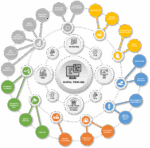
What is Building Information Modeling (BIM) and How Does it Impact The Built Environment?
Blueprints and physical drawings were once the standard for large capital projects. Project contributors would carefully consult these drawings before and during construction, to confirm that all design standards were met. Then, post-construction, project leaders would further compare physical buildings with the designs which informed them, to confirm an accurate build.
But the complexity of modern construction now requires a more modern solution — one that accounts for the many priorities and challenges a construction team faces during a project.
Construction leaders need a solution that manages project plans to a far greater degree. They need to be able to track how designs might change, how details are shared across contributors, and how knowledge from previous projects informs future projects. All of this ultimately prevents rework, streamlines project efficiency, and ensures that all contributors operate from the same set of digital, shareable designs.
These requirements make building information modeling (BIM) an absolutely indispensable tool in modern construction. Let’s dive a little deeper into why this is and explore BIM’s impact on the built environment.
What Role Does BIM Play in the Construction Space?
Building information modeling has helped radically reshape traditional workflows in modern construction. It improves project planning, coordination, documentation, clash detection, and monitoring — fields where even a brief lapse can create incredible costly delays or errors.
BIM has come to play a critical and far-reaching role in construction for leading companies across the world, impacting everything from project constructability and planning to risk management, sustainability, and budgeting.
Project Visualization and Planning
BIM provides a 3D model of a building project, which is far more comprehensive and informative than traditional 2D drawing sets. This advanced visualization allows stakeholders to see the entire project in a virtual space before construction even begins — completely revolutionizing their approach by providing a level of insight that was previously impossible to achieve.
BIM improves:
- Clarity: Achieve a better understanding of your project’s scope, scale, and details of individual elements.
- Pre-construction simulations: Simulate different construction scenarios to identify potential issues, or conflicts, before building begins.
- Design validation: Confirm that design concepts will translate well into physical elements. When you identify issues, make adjustments in the design phase to eliminate the potential for rework.
Sitewide Communication
BIM software serves as a central repository for all project information, ensuring that everyone involved in the project has access to the same, up-to-date information.
This collaborative environment fosters:
- Integrated workflows: Architects, engineers, contractors, and owners can work together on your project, ensuring that everyone is working with the same set of designs.
- Conflict resolution standards: Clash detection, a central BIM capability, helps identify issues between building systems — plumbing, electrical, etc. Issues can then be resolved before production begins.
Cost Estimation and Budget Management
BIM also significantly enhances the accuracy of cost estimations, which is crucial for budget management.
It enables:
- Cost analysis: BIM tools can link design elements to cost databases, allowing contractors to analyze the cost for each design change in real time.
- Budget tracking: BIM programs help contractors continuously monitor and update project costs. This keeps your project within budget.
Construction Scheduling
A category of BIM, referred to as 4D BIM, can integrate time-related information into the model. This supports:
- Project sequencing: 4D BIM adds time-related details to your BIM instance, providing a full picture of step-by-step sequencing and the dependencies from one step to the next.
- Timeline optimization: Identify potential delays and optimize your project’s schedule to improve efficiency.
- Progress monitoring: Track the physical building process to measure progress against original timelines.
Sustainability Standards
Every year, sustainability becomes more and more important for construction companies. Fortunately, BIM facilitates sustainable construction practices and energy-efficient building designs by enabling the following:
- Energy analysis: Building information models can include simulated energy performance and other design options that enhance energy efficiency.
- Lifecycle assessment: Contractors can use building information models to evaluate the environmental impact of materials and construction processes on a building’s lifecycle.
What are the Levels of Development (LOD) in BIM?
BIM involves various levels of detail, often referred to as Levels of Development (LOD). These levels define the amount of detail and information included in a building information model at different stages of a project’s lifecycle. LOD standards give architects, engineers, and designers a benchmark when discussing which details to include in, or exclude from, a particular design or document.
The six levels of development are a progression from conceptual designs (100) through operational models (500).
LOD 100: Conceptual Design
At LOD 100, models include basic elements that are indicative of the overall design concept. The information at this stage is mostly graphical and represents general shapes and locations of building components.
This level is used for feasibility studies, early design proposals, and initial project planning. It helps stakeholders understand the project’s scope and potential layout without delving into detailed specifications.
LOD 200: Schematic Design
LOD 200 involves more detailed modeling, where elements are defined with approximate geometry and spatial relationships. This level provides a clearer view of the project’s components and their interactions.
This stage is used for schematic design presentations, early design coordination, and preliminary cost estimates. It allows for basic analysis of design options and their impacts.
LOD 300: Detailed Design
At LOD 300, elements are modeled with precise geometry and specific dimensions, factoring in more detailed information about the materials, systems, and construction methods.
This level is used for advanced design development, coordination between disciplines, and the preparation of construction documents. It ensures that the design intent is fully captured and communicated throughout the project.
LOD 350: Construction Documentation
LOD 350 extends the detail of LOD 300 by including connections and interfaces between building components, ensuring that elements are modeled to include all necessary construction details.
This stage is used for producing comprehensive construction documentation and facilitating robust coordination and clash detection. Put simply, it helps in ensuring that the construction process is thoroughly and effectively planned.
LOD 400: Fabrication and Assembly
At LOD 400, the model includes additional information necessary for fabrication and assembly of building components. Elements are modeled with complete fabrication details, such as exact dimensions, shapes, and installation information.
This level is used for the actual fabrication of building components, construction planning, and on-site assembly. It certifies that all parts are manufactured and assembled as intended.
LOD 500: Real-Life Model Functionality
LOD 500 represents the as-built conditions of the completed project. The model includes precise information on the actual construction, including all modifications made during the construction process.
This stage is used for facility management, maintenance, and to support future renovations. It provides a comprehensive record of the building as it was constructed.
Finding the Right BIM Provider for Your Project
BIM is not a one-size-fits-all solution. It includes features meant to fit your project like a glove, whether you need clash detection, digital prefabrication, or generative design. It’s important to find a BIM service provider with the capabilities to handle your project — and the workforce, timelines, and materials that make it unique.
Your project deserves a BIM provider with the experience, the portfolio, and the technological proficiency to make your build a success from day one. To ensure you receive this and more, look for proficiency in these fields:
- Architectural BIM: 3D models that allow contractors to create, analyze, and visualize the various design elements of a project.
- As-built BIM: Virtual models that show as-built conditions of the existing environment.
- 4D BIM: 3D models that integrate time scheduling as a fourth dimension to improve how contractors visualize and coordinate design elements.
- 5D BIM: 4D models that also include resource-loaded schedules, incorporating cost as a fifth dimension for your project.
VIATechnik has long been a leader in the BIM services space. We’ve worked with leading clients in every major industry, from aviation to healthcare, offering tailored BIM solutions that save your team time, energy, and money. We’ll help you detail every major aspect of your project, centralizing details in ways that make data sharing easy. This type of transparency fosters healthy levels of accountability and eliminates errors before they become rework.
Connect with VIATechnik today to learn more about our building information modeling services and their application for your next construction project.



